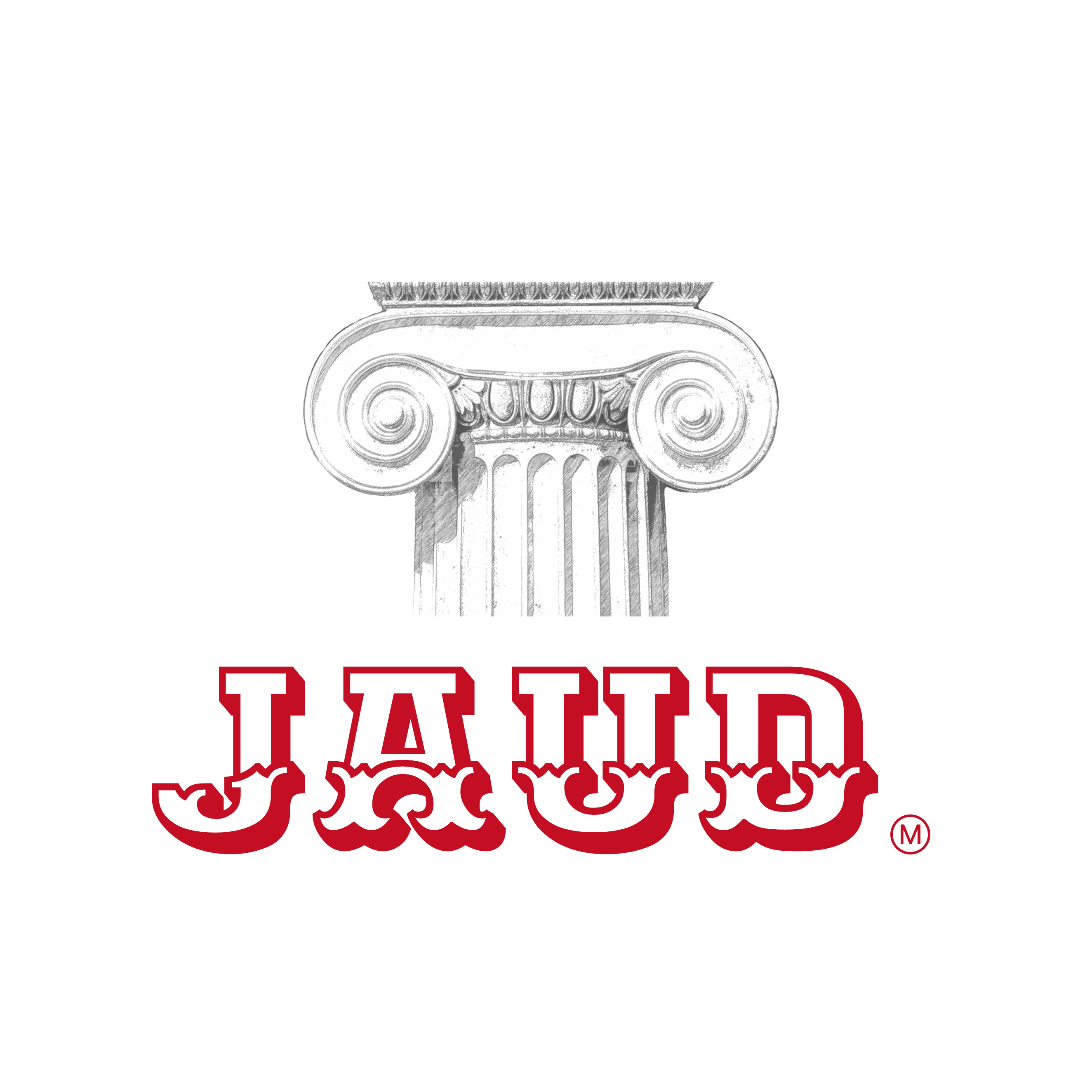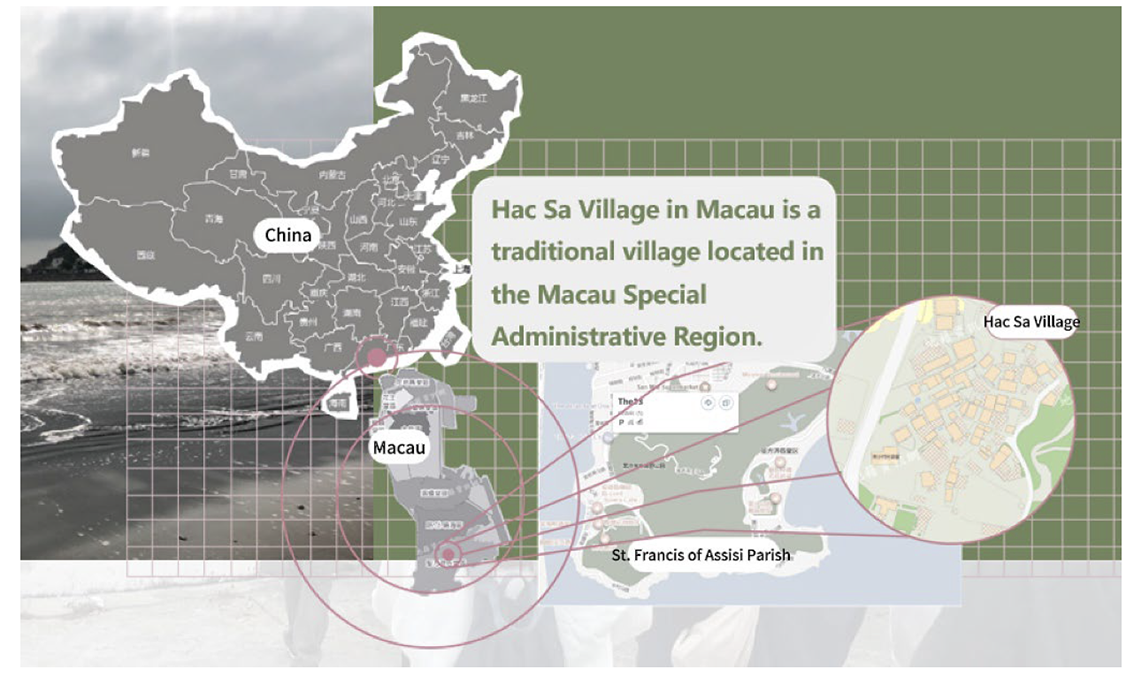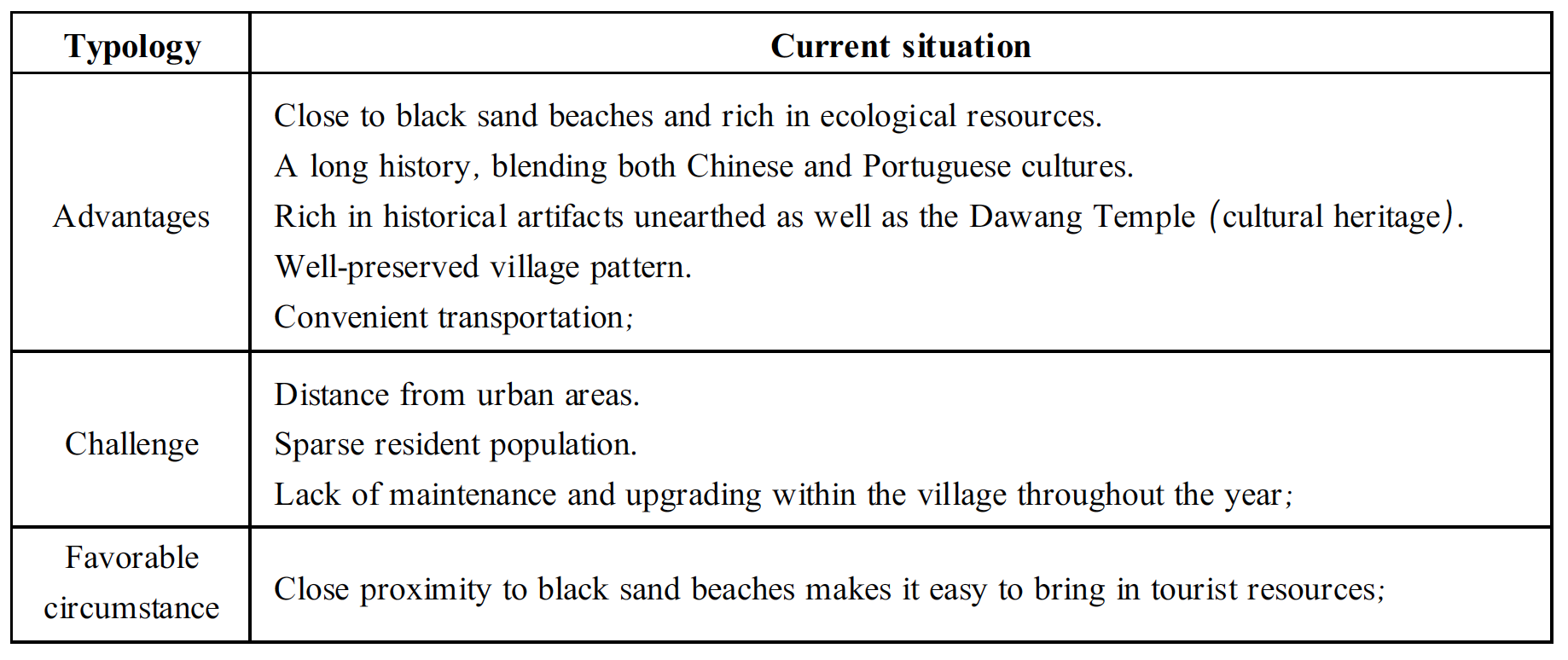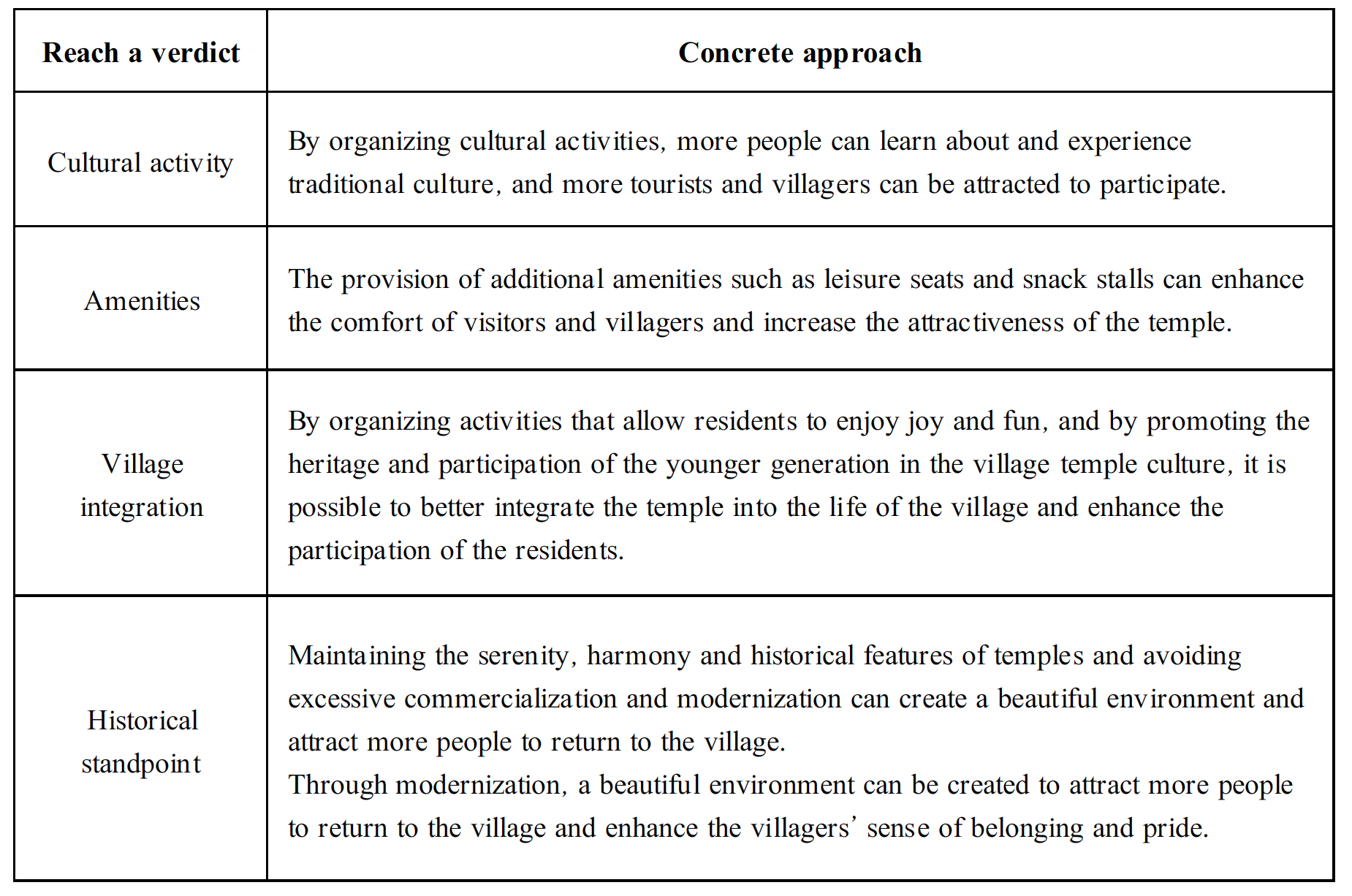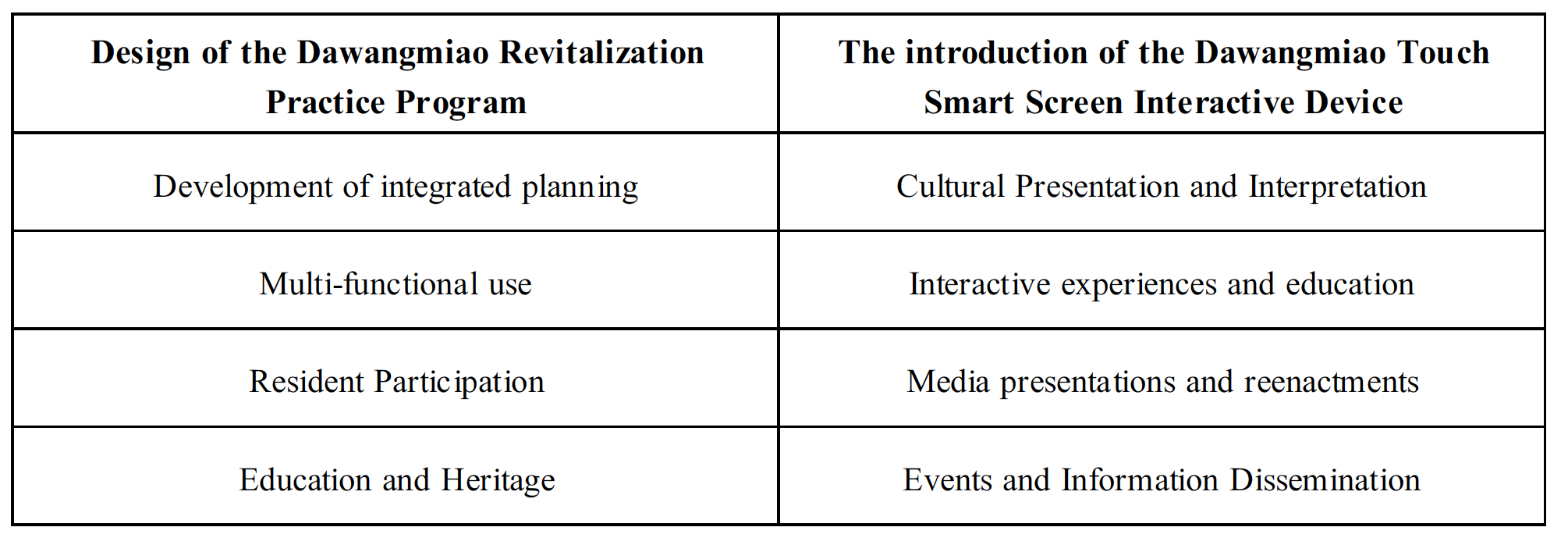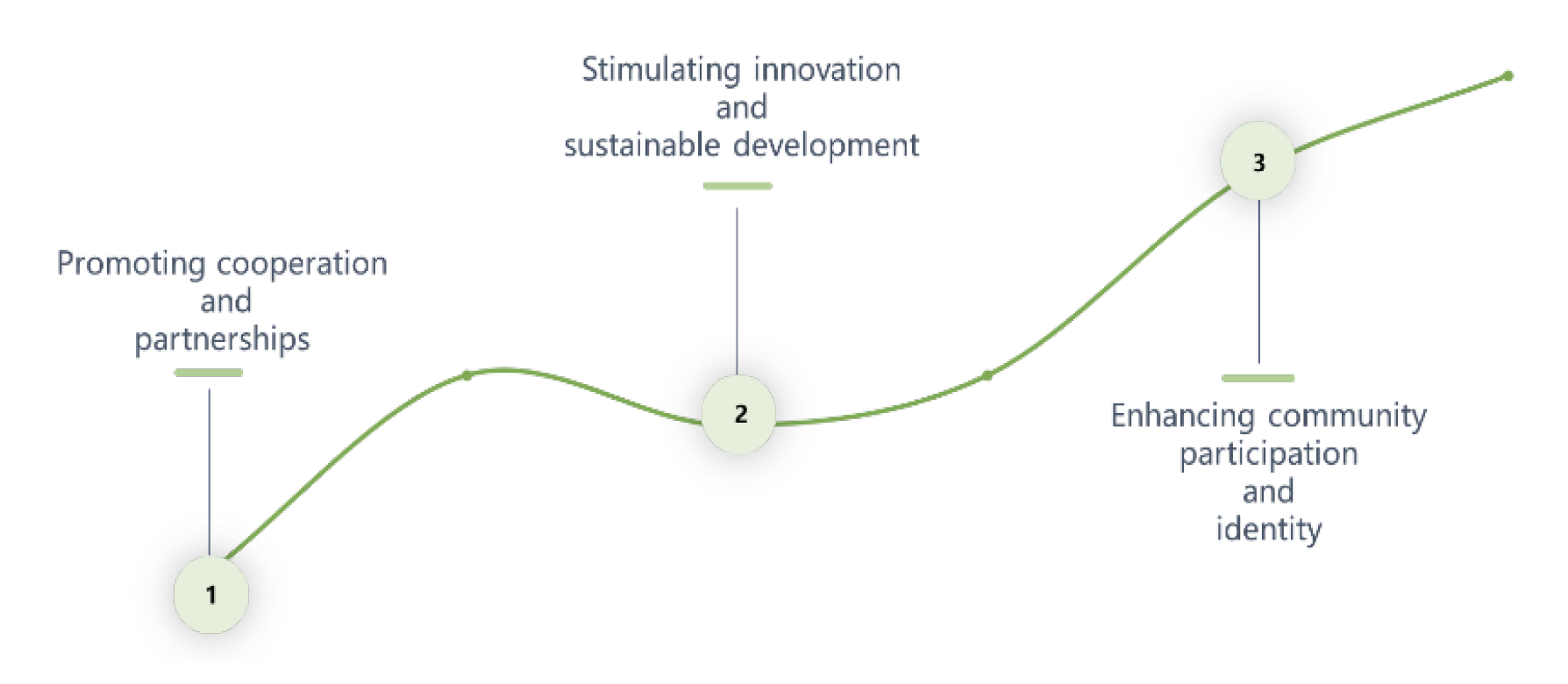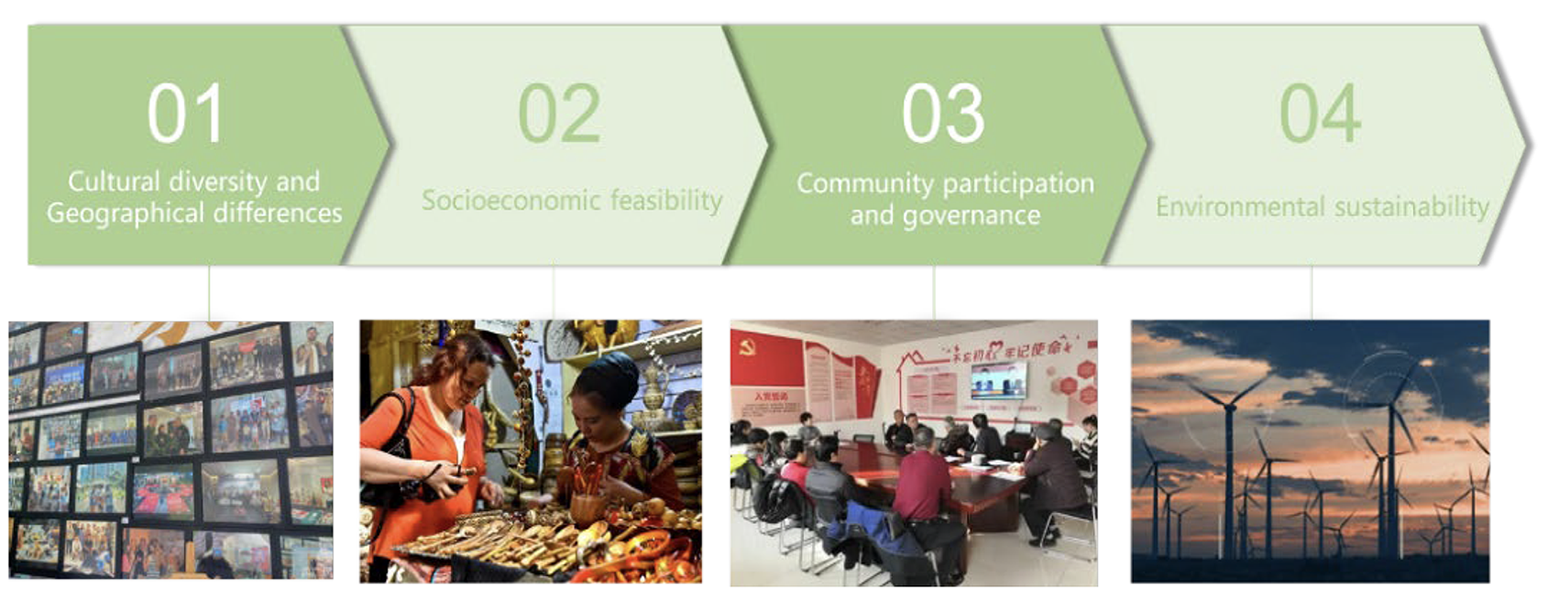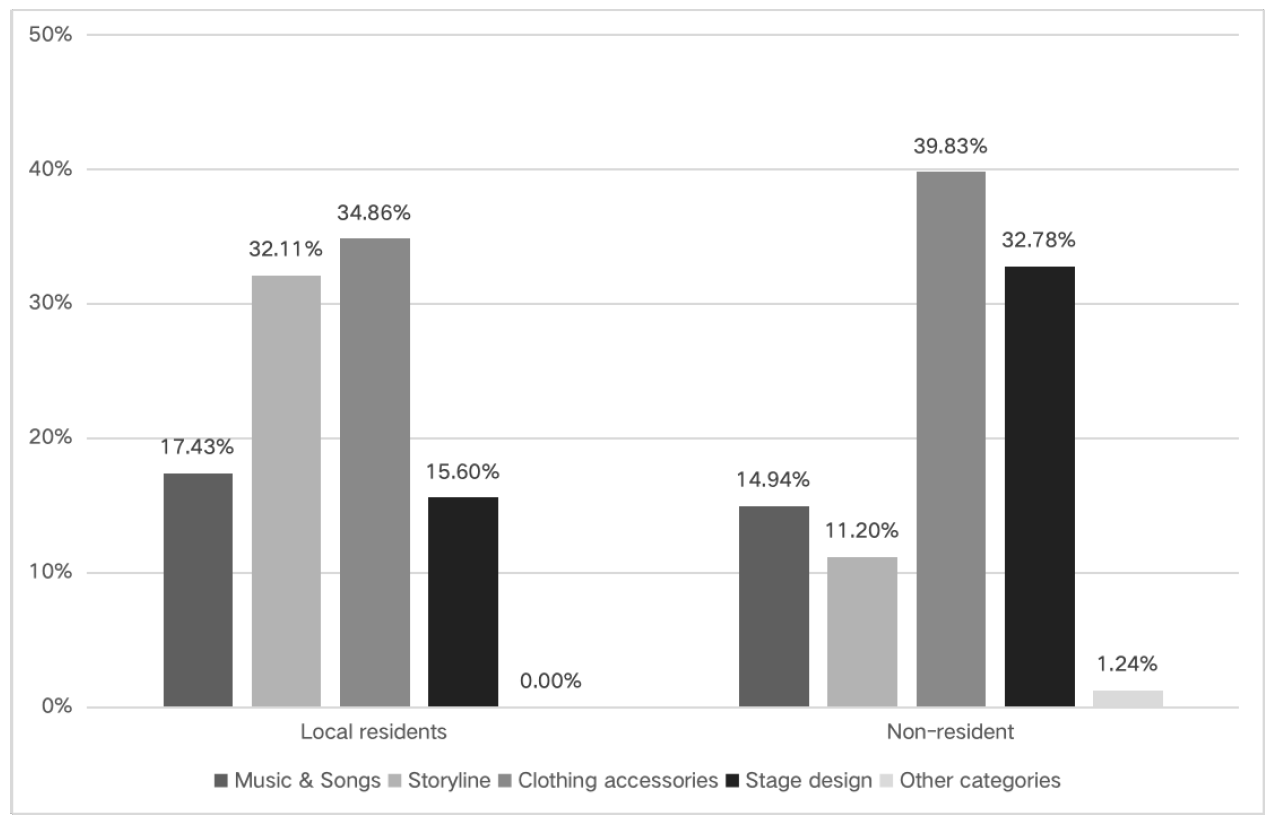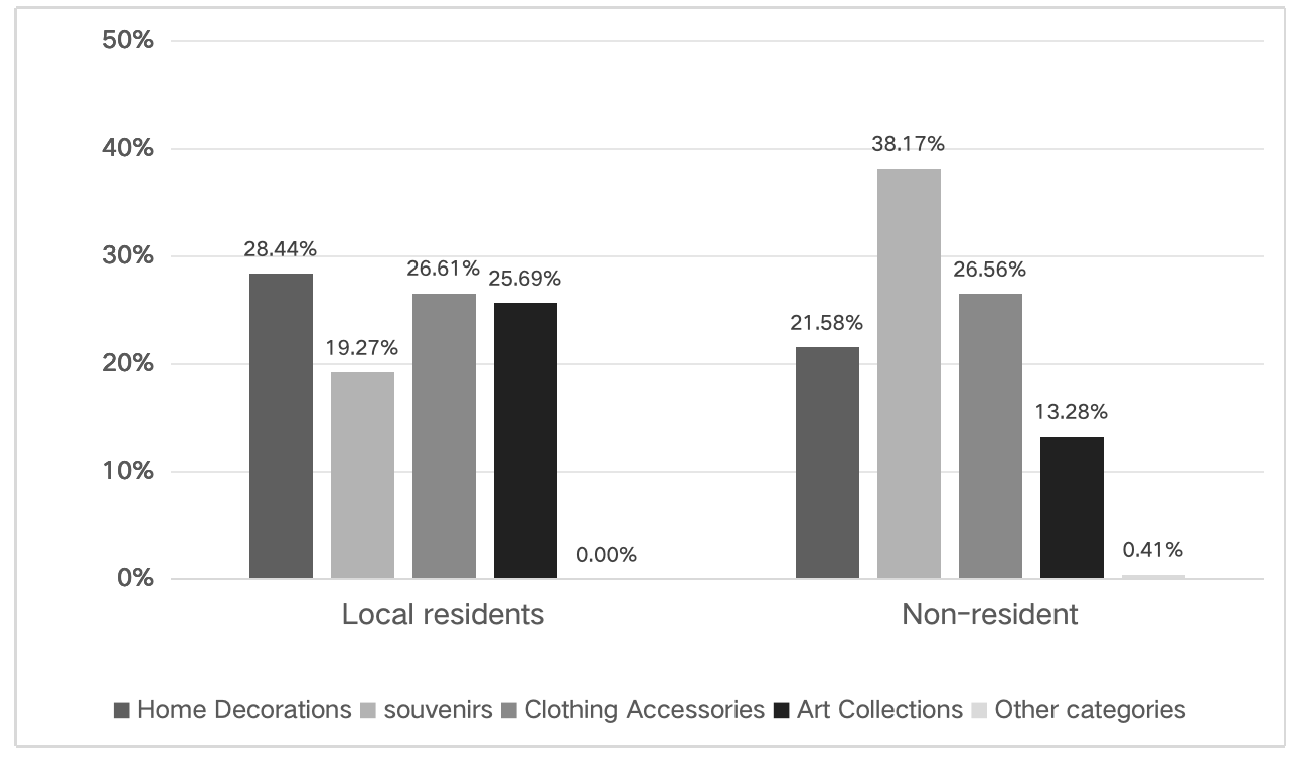2. Literature Review
2.1. Research on Catalyst Perspective Design
Amid rapid urbanization, traditional villages and their cultural landscape heritage are increasingly at risk of decline, abandonment, or even destruction. In response to this challenge, the catalyst theory offers new perspectives and approaches for the spatial revitalization of traditional villages. Xu Zijian and Ru Junhong, in their article "Research on the Design of Idle Space Revitalization of Traditional Villages under the Viewpoint of Catalyst", proposed that by refining the theory of the rural catalyst, innovative pathways can be developed for revitalizing numerous traditional villages that are currently in a state of idleness and decay, aligning with the high-quality development of urbanization [2].
The case of Santo Stefano di Sessanio in Abruzzo is a good example, as it exemplifies the reasoning of this study. It is a fortified medieval village situated on top of Gran Sasso, an area whose historical, cultural, and artistic heritage Daniele Kihlgren, a foreign entrepreneur, wished to restore and revitalize in the late 1990s. His approach was remarkably multidisciplinary, skillfully integrating knowledge and practices from a wide range of fields, including humanities and philosophy, anthropology, architecture, and economics. Through this comprehensive strategy, Kilgren aims not only to preserve cultural heritage but also to promote sustainable local socio-economic development, breathing new life into traditional villages. This approach reflects respect for history and a deep understanding of future development, providing an innovative path for the revitalization of traditional villages [3].
Zhu Wenliang et al., in Exploring the Path of Lower Tourism and Village Revitalization under the Guidance of Catalyst Theory, further elaborated on the concept of the soft catalyst. As a non-material catalyst, it stimulates regional vitality and promotes the development of cultural tourism through its intangible effects, ultimately contributing to the revitalization of rural areas [4]. Wang Xinxin and Zhu Rong, in Research on the Protection and Development of Ancient Villages under the Guidance of Catalyst Theory, explored how to apply urban catalyst theory to identify “catalyst elements” within villages. Their study aimed to address stagnation in the protection and development of ancient villages, such as Hesha Village [5]. In their study, Mangeli and Sattaripour drew on previous research achieved at the Meymand Cultural Heritage Site, supplementing it with interviews, photography, and field data collection from the villages, which they then analyzed and compiled [6].
Hsiao states that community participation is a crucial factor in cultural heritage preservation and environmental improvement. He emphasizes that assessing the value of heritage for different groups within a city and integrating appropriate visualization tools for new development can enhance community engagement. This, in turn, is essential for any discussion on sustainable urban development [7].
Abstract
With modernization and urbanization, many temples face the threat of abandonment and destruction, resulting in the loss of cultural heritage and a decline in village cohesion. Therefore, the revitalization of traditional village temples-an important element of cultural heritage- holds great cultural, social, and economic significance. This research explores the background, significance, and design strategies for revitalizing traditional village temples, guided by a tactile perspective. Design concepts and principles are proposed to enhance resident participation and strengthen village identity by reactivating temple functions and providing diversified services and activities. This research also analyzes different temple revitalization practices through field research and case studies, focusing on the transformation and renewal of cultural activity centers, the integration and interaction between temples and villages, and the sustainable development and utilization of resources. The effectiveness and sustainability of temple revitalization design in traditional views from a tactile perspective- are evaluated by analyzing the impact of implemented design practices. Furthermore, this study examines the challenges and opportunities associated with temple revitalization from a catalyst perspective and proposes policies and strategies to advance this design approach. Temple revitalization, when approached as a catalyst, can help preserve and transmit cultural heritage, foster community development, facilitate sustainable growth, and contribute to the dissemination of cultural values as well as the promotion of sustainable tourism.
1.1. Research Background
With the acceleration of urbanization and the migration of a large number of people into cities, the preservation of traditional villages has been greatly challenged. Consequently, the vitality of these traditional villages has gradually declined amidst ongoing social changes, and the proportion of empty-nest elderly residents has steadily increased. In the twenty-first century, the total number of natural villages in our country was 3.63 million. However, by 2010, within just ten years, this number had sharply declined to 2.71 million, resulting in a loss of 900,000 natural villages [1]. As evident, traditional village temples are an important part of cultural heritage. Through revitalization design, the history, values, and traditional knowledge they embody- as well as the cultural practices and rituals associated with them- can be preserved and transmitted to future generations. Village temples serve as the heart of community life, offering a vital space for fostering social cohesion and reinforcing village identity. Through revitalization design, these temples can be reactivated to support a wide range of functions, providing social, educational, cultural, and recreational services and activities for residents.
1.2. Research Questions
With the exodus of young people from traditional villages, the rising proportion of the aging population, and the younger generation’s growing disinterest in traditional practices, youth engagement in the cultural heritage of temples has greatly declined. Relying solely on the elderly to safeguard these temples is insufficient to ensure the sustainable development of both the temples and the villages they serve. This, in turn, makes it challenging to preserve and promote the rich historical and religious culture embedded in these temples. The decline in village population is also likely driven by a lack of a sense of belonging and pride in communities.
The main objective of this research is to explore the cultural significance of Da Wang Temple in Hac Sa Village, Macau, and to identify elements suitable for revitalization and redesign. This aims to stimulate a sense of responsibility among villagers, encourage active participation in the temple’s preservation and community development, and foster greater engagement and cultural inheritance among the younger generation (Figure 1).
(photographed by Zirou Hu)
1.3. Research Purpose
The purpose of the research is to investigate the conservation and revitalization of Da Wang Temple in Hac Sa Village, Macao, and to introduce the theory of urban catalysts as a strategic approach to addressing these challenges. Specifically, the research aims to explore the methods for revitalizing village temple culture through cultural activities, festivals, and exhibitions, while also examining how new media and digital technologies can be leveraged to promote village temple culture and enhance its appeal and influence. To explore ways to enhance villagers’ sense of identity and pride in village temple culture, this research will analyze the role of education and community activities in strengthening cultural awareness. Also, it will examine how community participation projects can motivate villagers to actively engage in the preservation and development of village temple culture.
At the same time, this study aims to promote the inheritance of village temple culture by encouraging greater participation from the younger generation. It will further explore ways to cultivate their interest in this cultural heritage, helping them recognize the importance of preserving and passing down traditional culture. Most importantly, this study aims to address the issue of population decline in traditional villages by exploring strategies to improve village infrastructure, enhance quality of life, and attract people—especially younger generations—back to rural areas. It also seeks to strengthen the interaction between villages and cities, while promoting the inheritance and continued development of local culture.
This research also aims to provide practical insights into temple revitalization design and explore how to achieve resident participation, sustainable development, and cultural preservation throughout the revitalization process. Also, it seeks to promote the formulation of policies and strategies related to temple revitalization design, offering policy support and cooperative frameworks. This will help facilitate future collaboration among the government, NGOs, and village communities to ensure the effective implementation and long-term sustainability of temple revitalization efforts.
Overall, the study aims to realize the preservation and development of temples with positive impacts on village inhabitants, cultural heritage, and socio-economic development.
Catalysts play an important role in cultural heritage preservation and revitalization, stimulating innovation and sustainable development, enhancing the participation and identity of villages in Macao, and fostering multi-party cooperation and support. Through the role of catalysts, the effective conservation, transmission, and revitalization of cultural heritage can be better achieved, infusing it with new vitality and significance in a rapidly developing modern society.
4.2.2. Application of the Catalyst Perspective in the Revitalization Design of Temples
Natural and cultural resources are the basis of the cultural and creative industries, and culture itself consists of the collective behavior formed by people interacting with and adapting to local natural conditions. In a formal approach, the emphasis is on the use of local natural resources to convey a particular idea in the form of products, places, and festivals [6].
In temple revitalization design, the theory of catalysis can play a key role in promoting the preservation, heritage, and revitalization of temples. Catalyst encourages cooperation between stakeholders in temple revitalization design, including temple management agencies, local government, Hesha Village residents, cultural institutions, and the tourism industry. Catalyst can promote dialogue and collaboration among all parties, harmonize the balance of different interests, and form a common goal and action plan for temple conservation and revitalization.
For the revitalization design of Dawang Temple, innovative solutions need to be proposed to address the real challenges, such as how to balance the religious function and cultural tourism needs, and how to enhance the sustainable activity mode of the temple. Catalyst can stimulate innovative thinking in design, promote sustainable development practices, and ensure the temple’s long-term viability and sustainability. The catalyst perspective puts more emphasis on the importance of village participation and identity in temple revitalization design. Dawang Temple, as an integral part of Hesha Village, plays a vital role in fostering community participation and cultural identity.
First, catalysts can stimulate villagers’ sense of participation and initiative, enabling them to become the central agents in the revitalization design of the temple. By encouraging community members to offer opinions, make suggestions, and actively participate in the decision-making and implementation processes, catalysts foster a sense of ownership and responsibility. Secondly, catalysts promote cultural education and intergenerational transmission of heritage within the framework of temple revitalization. As a vital repository of traditional culture in Hesha Village, the Dawang Temple’s renewal should prioritize the preservation and dissemination of its rich culture. Finally, catalysts support cross-border cooperation and resource integration in temple revitalization design.
Nowadays, research is no longer a one-sided analysis, but more of it is already a cross-field and interdisciplinary research. Thus, the temple revitalization design actually involves a number of fields, such as history, architecture, cultural heritage management, and tourism planning. From the catalyst perspective, professional organizations and experts in different fields can be coordinated, and resources from various parties can be integrated to participate in the revitalization design of temples to ensure the comprehensiveness and feasibility of the design proposals.
By applying the catalyst perspective, temple revitalization design can fully harness the cultural heritage value of temples, ensuring their protection, inheritance, and revitalization. This approach not only fosters innovation and sustainable development but also enhances participation and cultural identity among both villagers and tourists. Furthermore, it encourages cross-sector collaboration and resource integration, strengthening the long-term impact of revitalization efforts.
References
1. Fung, J. C. “The Dilemma and the Way Out of Traditional Villages—Another View on Traditional Villages as an Alternative Cultural Heritage.” Folk Culture Forum, no. 1 (2013): 7–12. (In Chinese)
2. Xu, Z. J., and Rong Junhong. “A Study on the Revitalization Design of Traditional Village Idle Space from the Perspective of Touching Media—The Case of Gangtou Village in Guangzhou.” Industrial Design, no. 12 (2022): 76–78. (In Chinese)
3. Gorgo, L., and G. Riggi. “Urban Traces: Revitalization Strategies for Abandoned Villages.” In City and Territory in the Globalization Age: Proceedings of the 24th ISUF International Conference, Valencia 2017, 843–849. Valencia: Editorial Universitat Politècnica de València, 2018. [CrossRef]
4. Zhu, W.-L., F.-M. Lian, and W.-J. Duan. “Exploration of the Path of Following Travel and Village Revitalization Guided by the Theory of Catalyst: Taking Zecheng Village of Mada Town as an Example.” Residential Science and Technology, no. 7 (2024): 55–61. (In Chinese)
5. Wang, X. X., and Rong Zhu. “Research on the Protection and Development of Ancient Villages Guided by Catalyst Theory—Taking Yanjiaqiao in Wuxi as an Example.” Journal of Western Habitat Environment, no. 6 (2018): 111–115. (In Chinese)
6. Mangeli, M., and A. Sattaripour. “A Report on the Potentialities of Restoration and Revitalization of the Historical Village of Meymand, Iran.” WIT Transactions on Ecology and the Environment 120 (2009): 389–399. [CrossRef]
7. Hsiao, H. “From Squatter Settlements to Cultural Heritage: The Preservation and Revitalization as a ‘Group of Buildings’ Based on the Case Experience of Treasure Hill Art Village in Taipei City, Taiwan.” Journal of Asian Architecture and Building Engineering 21, no. 2 (2022): 644–661. [CrossRef]
8. Musyawaroh, M., T. S. Pitana, M. Masykuri, and Nandariyah “Sustainable Revitalization in Cultural Heritage Kampong Kauman Surakarta Supported by Spatial Analysis.” IOP Conference Series: Earth and Environmental Science 123, no. 1 (2018). [CrossRef]
9. Du, Pinpin, and Jichao Chen. “Digital Revitalization of Cultural Landscape Heritage in Shen’ao Village, Zhejiang Province.” Zhejiang Archives, no. 9 (2023): 11–14. (In Chinese)
10. Wang, K., et al. “Research and Application of Digital Innovation Technology for Traditional Village Protection and Inheritance.” Construction Science and Technology, no. 7 (2022): 91–93. (In Chinese)
11. Gong Houyu, and Li Xin. “Let the Ancient Villages ‘Live’ Up.” China Construction News, January 5, 2024, 3. (In Chinese)
12. Wang, T. Y., Yurong Qi, and R. Tao. “Study on the Spatial Revitalization Design of Northeastern Historical and Cultural Villages Oriented to Cultural and Ecological Tourism: The Example of Daughter City Village in Linjiang Township, Lanxi County.” Residence, no. 8 (2020): 39–40. (In Chinese)
13. Liu, M., and G.-N. Wei. “Research on the Protection and Revitalization Design of Traditional Villages: Taking Haiyan Village in Kunming as an Example.” Urban Architecture, no. 32 (2020): 42–46. (In Chinese)
14. School of Architecture and Urban Planning, Kunming University of Technology. Spatial Means of Rural Revitalization: 2016 Joint Graduation Design of Four Schools Majoring in Urban Planning, Architecture, and Landscape Architecture. Beijing: China Architecture Industry Press, 2016. (In Chinese)
15. Xu, J., Y. Peng, and S. Y. Zhu. “A Study on Digital Conservation and Inheritance of Tujia Ancient Villages in Western Hunan.” Border Economy and Culture, no. 7 (2023): 60–63. (In Chinese)
16. Zong, Z. Z. Research on the Strategy of Revitalization and Utilization of Rural Idle Space from the Perspective of Catalyst Master. Master’s thesis, Inner Mongolia University of Technology, 2021. (In Chinese)
17. Zhen, L. E., Jing Lan, and Jiaqi Cai. “Research on the Revitalization Strategy of Traditional Villages Based on Catalyst Theory: Taking Peitian Village in Fujian Province as an Example.” Fujian Architecture, no. 8 (2017): 1–4. (In Chinese)
18. Ni Chang, and Ping Wang. “Research on the Application of ‘Digital Technology’ in the Protection and Revitalization of Ancient Villages: Taking Qujiawan Town of Honghu City, Hubei Province as an Example.” Chinese Literary Artist, no. 4 (2018): 116. (In Chinese)
19. Chen, C.-K., Y. Yu, and K.-R. Jiang. “Research Progress and Methodological Exploration on the Protection and Development of Traditional Villages in China from the Perspective of Touchmedia: A CiteSpace-based Knowledge Mapping Analysis.” Urban Development Research, no. 9 (2022): 22–27. (In Chinese)
20. Li, J. A Study on Renewal Strategies of Mountain-type Traditional Villages in Shanyang County under the Perspective of Catalyst Theory. Master’s thesis, Xi’an University of Architecture and Technology, 2021. (In Chinese)
21. Guan, Yujun. A Study on Renewal Strategies of Traditional Villages in Beijing Suburbs from the Perspective of Catalyst Effect. Master’s thesis, Beijing Architecture University, 2018. (In Chinese)
22. Fan, Bi-Qing. Exploring the Sustainable Development Model of Traditional Villages in Jincheng City, Shanxi Province. Master’s thesis, Taiyuan University of Technology, 2018. (In Chinese)
23. Yang, C. H., Y. Sun, P. H. Lin, and R. Lin. “Sustainable Development in Local Culture Industries: A Case Study of Taiwan Aboriginal Communities.” Sustainability 14, no. 6 (2022): 3404. [CrossRef]
24. Yu, C.-P., S. Cole, and H. Chancellor. “Resident Support for Tourism Development in Rural Midwestern (USA) Communities: Perceived Tourism Impacts and Community Quality of Life Perspective.” Sustainability 1 (2018): 802. [CrossRef]
25. Xu, J., L.-K. Tao, H. Zhang, and J.-W. Fang. “Digital Revitalization and Conservation Design of Village Culture Based on Cultural Characteristics: The Case of Xinye Ancient Village.” Rural Practical Technology, no. 4 (2022): 9–11. (In Chinese)
26. Chang, S., and R. Lin. “A Framework of Experiential Service Design in Creative Tourism.” In Culture and Computing. HCII 2019. Lecture Notes in Computer Science, vol. 11576, 3–16. Cham: Springer, 2019. [CrossRef]
© 2025 by the authors. Published by Michelangelo-scholar Publishing Ltd.
This article is published under the Creative Commons Attribution-NonCommercial-NoDerivs 4.0 International (CC BY-NC-ND, version 4.0) license (https://creativecommons.org/licenses/by-nc-nd/4.0/), which permits non-commercial use, distribution, and reproduction in any medium, provided the original work is properly cited and not modified in any way.
Share and Cite
Chicago/Turabian Style
Zirou Hu, and Xin Hu, "Research on the Revitalization Design of Traditional Village Temples from the Perspective of Catalysts: A Case Study of Hac Sa Village in Macau" JAUD 2, no.1 (2025): 46-66.
AMA Style
Hu ZR, Hu X. Research on the Revitalization Design of Traditional Village Temples from the Perspective of Catalysts: A Case Study of Hac Sa Village in Macau. JAUD. 2025; 2(1): 46-66.
Table of Contents
- Abstract
- Introduction
- Literature Review
- Research Methodology
- Research Process
- Conclusions and Outlook
- Author Contributions
- Funding
- Acknowledgments
- Conflicts of Interest
- Author Biographies
- References
1. Introduction
Against the backdrop of rapid modernization and urbanization, many traditional villages and their temples face the risk of decline, abandonment, or even destruction. This not only endangers valuable cultural heritage but also weakens the cohesion and socio-cultural identity of these communities. In response to this challenge, this study introduces the concept of “catalysts”-originally applied to urban design by American scholars, Wayne Otto and Don Logan- to describe elements or projects capable of triggering a positive chain reaction and fostering the progressive development of a city.
This study focuses on how to apply catalyst theory to the conservation and development of traditional villages and their temples. By exploring the application of the catalyst effect in traditional villages, this study aims to provide new theoretical insights into the conservation of traditional cultural heritage and propose practical strategies for the sustainable development of these communities. The goal is to preserve and strengthen local cultural identity while achieving a win-win outcome that balances cultural conservation with social and economic development.
Musyawaroh et al. stated that the sustainable revitalization of Kaumanchester can be achieved through:
- Improvements to the physical environment, including land and building use, green open spaces, and recreational parks; and
- Enhancement of the non-physical environment, encompassing economic development, heritage preservation, socio-cultural factors, and active involvement of relevant stakeholders in the cultural heritage revitalization process [8].
In addition, the application of digital technology has also injected new impetus into the sustainable development of traditional villages. Du Pinpin and Chen Jichao, in Exploration of Digital Revitalization Path of Cultural Landscape Heritage in Shen’ao Village, Zhejiang Province, emphasized that, in the long run, digital culture construction serves as the driving force for the sustainable development of traditional villages. They argue that it can effectively enhance the protection and transmission of cultural heritage [9]. Wang Kai et al., in their project ‘Research and Application of Digital Innovation Technology for the Protection and Inheritance of Traditional Villages,’ emphasized the crucial role of digital technology in the preservation and development of ancient villages. By digitally collecting, displaying, visualizing, and disseminating cultural resources, digital technology helps achieve a catalytic effect, transforming individual elements into a holistic revitalization approach and facilitating the regeneration of inactive villages [10].
By drawing on the ideas of Xu Zijian and Ru Junhong on perfecting the theory of village catalysts, this study focuses on the temple as a specific cultural symbol, exploring its possibilities as a catalyst element and how to activate them through design interventions to promote the overall revitalization of the village. The concept of soft-touch media proposed by Zhu Wenliang et al. is crucial to understanding the role of temples at the psychosocial level. Temples are not only a part of tangible cultural heritage but also hold profound socio-cultural and religious significance, serving as a vital emotional bond that unites the community.
Therefore, this study will deeply analyze how temples act as a kind of intangible catalyst to stimulate the emotional resonance of villagers and tourists and enhance community cohesion by organizing cultural activities or religious ceremonies. The research of Xinxin Wang and Rong Zhu provides direct methodological guidance for this study. Using Hesha Village as a case study, this research will identify and apply “catalyst elements” to explore innovative approaches to temple revitalization. Building on the insights of Du Pinpin and Chen Jichao, Wang Kai, and others on digital technology, this study will also explore the potential of digital culture construction in temple revitalization. It will examine how new media interactions and other technological tools can enhance public awareness of temple history and culture while fostering a greater sense of participation.
This study not only builds upon the theoretical framework established by previous scholars but also proposes specific design strategies for traditional village temples, offering both significant academic value and practical application prospects. By applying catalyst theory to the revitalization design of traditional village temples, this study aims to provide valuable case references and support for other traditional villages facing similar challenges, ultimately fostering a win-win scenario for both cultural conservation and social development.
5. Conclusions and Outlook
5.1. Summary of Key Research Findings
In such a social environment, tourists are gradually gravitating towards cultural activities [26]. The relevant departments should increase their focus on education and resources to help people truly recognize the value of national culture. For historical and cultural villages like this, protection and excavation should be carried out immediately. Temple cultural activities, along with cultural and ecological tourism, can serve as catalysts to showcase the village’s historical and cultural heritage using various techniques, stimulate the village’s economic vitality, and reshape the spirit of the place. These will make the village become a place where traditional civilization is intertwined with scientific and technological civilization, and where historical culture is intertwined with modern culture [9].
5.2. Limitations of the Research and Recommendations for Further Research
There may be some limitations when conducting research on the revitalization design of traditional village temples from the catalyst perspective.
Revitalization design from the tactile perspective is usually based on general principles and frameworks, which may not be able to fully take into account the special needs and differences in different regional and cultural contexts. Further studies could conduct in-depth surveys and analyses of traditional village temples in different regions and cultural contexts, to develop more specific and individualized design strategies. Further research can explore different forms and mechanisms of village participation, focusing on how to establish effective partnerships and communication channels. Also, it can investigate how to promote the active participation and initiative of village residents in temple revitalization design.
The revitalization design of temples from a tactile perspective also needs to be evaluated and monitored for its effectiveness, through which the actual impact and effectiveness of the design solutions can be understood. Further research can involve long-term monitoring studies to assess the impact of temple revitalization design on aspects such as temple preservation, community development, and tourism. This would allow for timely adjustments and improvements to the design strategies.
To summarize, further research can be carried out in terms of cultural diversity and regional differences, socio-economic feasibility, village participation and governance, environmental sustainability, as well as effect assessment and monitoring. These studies will help to deepen the theory and practice of temple revitalization design for traditional villages from a tactile perspective and promote the conservation, inheritance, and sustainable development of Dawang Temple (Figure 6).
During the initial visit, we focused on the historical importance, cultural significance, state of preservation, and level of community involvement in the Mahamudra Temple. Through these observations, we were able to ensure the validity and credibility of the research data. By meticulously examining the temple’s architectural features (e.g., construction, layout, structural details, and decorative elements), we were able to get a comprehensive picture of the temple’s active characteristics and physical state, including its damage and maintenance needs.
It is worth noting that there exists an underutilized space containing a water well near the Dawang Temple. This finding opens up the possibility of subsequent revitalization design, where the area can be renovated to optimize the use of existing underutilized resources, thereby enhancing both the functionality and community appeal of the entire temple area. The second research is mainly based on interviews and exchanges with village chiefs and villagers to understand their perceptions, needs, and expectations of the temple and some of the current problems of Dawang Temple and the village. Through interviews, information on the oral history and cultural activities related to the temple can be obtained, thereby enriching the data and figures of the research (Table 1).
4.2. Design Concepts and Principles Under the Catalyst Perspective
4.2.1. The Role of the Catalyst Perspective in Cultural Heritage Preservation and Revitalization
In this paper, “catalyst” refers to an agent of change and collaboration that stimulates motivation, facilitates cooperation among various stakeholders, and advances the preservation, transmission, and revitalization of cultural heritage. Urban catalysts are a familiar concept that rural practitioners have introduced into rural construction, resulting in the application of the concept of “rural catalysts” [16]. Rural catalysts can be categorized into physical and virtual catalysts. The former refers to the material spaces that carry vitality factors, while the latter pertains to immaterial forms, such as economic and cultural activities planned by the rural construction team [17].
Specifically, catalysts include media, revitalization elements of the village (listed in a later table), and modern interactive tools such as touch-screen displays. These digital media serve as catalysts by offering interactive experiences and information dissemination, accelerating cultural inheritance, and fostering greater social participation. Ni Chang et al. introduced the concept of ‘digital technology’ to analyze the characteristics of the public space in ancient villages and the interaction between people and these spaces, aiming to enhance their functionality and diversity while promoting the protection and revitalization of ancient villages [18].
Sustainable development can also serve as a practical foundation for local revitalization, as cultural heritage can become a driving force for sustainable development, with authenticity serving as a core value of culture [3]. The catalyst perspective in cultural heritage preservation and revitalization can facilitate the establishment of cooperation and partnership among different stakeholders. The role of the catalyst carrier is very useful for the continuation of the traditional cultural heritage and the realization of the overall renewal of traditional villages [19].
In the process of cultural heritage preservation and revitalization, the catalyst can establish cooperation and partnership by facilitating dialogue among different parties and coordinating the balance of different interests, to synergize multi-party participation. The catalyst perspective helps to stimulate innovative thinking and sustainable development practices. The conservation and revitalization of Dawangmiao, as a cultural heritage of Hesha Village, must address real challenges, such as insufficient funds, management difficulties, and limited participation from villagers. Catalyst can encourage all parties to seek innovative solutions and explore sustainable economic models and social development approaches to ensure the long-term protection and revitalization of cultural heritage.
An equally important aspect is that the catalyst perspective highlights the significance of village participation and identity (Figure 5). Therefore, one of the primary goals of local revitalization should be the preservation and transmission of local culture and traditional skills, as the neglect or improper application of traditional culture often leads to backlash from residents [3]. The conservation and revitalization of Dawangmiao should be a common village affair, which requires the participation and support of a wide range of villagers. The role of the catalyst is to stimulate the community’s sense of participation and initiative, positioning it as the main driver of cultural heritage conservation and revitalization, while enhancing residents’ sense of identity and responsibility toward Dawangmiao.
4. Research Process
4.1. History and Background of Temple Revitalization in Traditional Villages
4.1.1. Cultural Significance of the Dawang Temple
Dawang Temple, as the spiritual and cultural center of Hesha Village, serves as a symbol of village cohesion. When returning to their hometown, villagers visit the temple daily to offer incense, reflecting its sacred significance in their lives. The deep respect and belief in the temple foster a strong sense of belonging among the villagers. The presence of incense smoke, symbolizing the vibrancy of life, mirrors the prosperity of the village. The temple’s development and frequency of use can thus serve as indicators of the village’s overall vitality and social well-being. Viewed from this perspective, Dawang Temple holds the potential to foster communication and interaction among villagers, while enhancing the village’s cohesion and sense of belonging. Dawang Temple is also the carrier of the traditional culture of Hac Sa Village, which carries the rich historical, cultural, and artistic elements of the past when it was invaded by the Portuguese. The murals, sculptures, and other artworks in DaWang Temple demonstrate the traditional craftsmanship skills and aesthetic concepts of the olden days, which are of great significance for cultural transmission and education for future generations.
4.1.2. Historical Background of Traditional Village Temples
Traditional village temples often have a long history, spanning hundreds of years or more. The rise and fall of these temples and buildings serve as a record of the historical development, humanistic features, and social changes of the local villages, making them important materials for historical and cultural research. While the Da Wang Temple in Hesha Village bears traces of Portuguese cultural influence from the colonial period, it primarily reflects local traditional architectural culture in its style and construction techniques. Temples in other regions may feature unique architectural forms, structural layouts, and decorative styles, showcasing the exquisite craftsmanship and aesthetic values of ancient Chinese architecture. However, this research focuses more on the cultural heritage and the development of new media introduction in Dawang Temple, which has historically played an important role in the village. In addition to religious ceremonies and rituals, temples also acted as centers for village meetings, education, and cultural dissemination, etc., which had a profound impact on local social life.
Therefore, the cultural significance and historical background of Dawang Temple not only reflect religious beliefs and village cohesion but also embody rich historical and cultural connotations. It is thus clear that the protection and revitalization of the culture of Dawang Temple in Hesha Village is of great significance to the inheritance of the excellent traditional culture of the Chinese nation, the promotion of village development, and the enhancement of people’s sense of cultural identity.
4.1.3. Problems and Challenges Facing Dawangmiao in Hesha Village
The analysis of the research interviews revealed issues such as the aging and deterioration of the building, coupled with a lack of financial and technical support for necessary updates and maintenance, posing a threat to the architectural safety of the temple. Also, it was learned that the temple underwent renovation and reconstruction following its destruction during the period of Portuguese rule. Thus, the more pressing issue at present is the loss and erosion of cultural heritage. With the advancement of modernization, the historical, cultural, and artistic elements embodied by traditional village temples are gradually fading. More importantly, the younger generation shows less interest in traditional beliefs. Also, the lack of inheritance and maintenance of temples is a significant factor contributing to the gradual decline of temple culture. It has been found in numerous studies that the development of temples is easily accompanied by over-development, losing their original religious nature and cultural connotations. Over-commercialization may also lead to the destruction of the temple environment and distortion of its landscape.
Indigenous peoples’ way of life is deeply rooted in ancestral traditions. The urgent challenge is how to add value through creativity, integrating elements of science and technology to both preserve tradition and meet contemporary needs [3]. To cope with these problems and challenges, it is necessary to strengthen cross-sectoral cooperation and coordination and to form a working mechanism in which many parties can participate. This approach can both protect and revitalize the culture of Dawangmiao Temple in Hesha Village, enabling it to fulfill a wider range of functions and hold greater significance in modern society.
Research on the Revitalization Design of Traditional Village Temples from the Perspective of Catalysts: A Case Study of Hac Sa Village in Macau
by
Zirou Hu , Xin Hu *
Faculty of Innovation and Design, City University of Macau, Macau
* Author to whom correspondence should be addressed.
JAUD. 2025, 2(1), 46-66; https://doi.org/10.59528/ms.jaud2025.0426a4
Received: November 15, 2024 | Accepted: March 10, 2025 | Published: April 26, 2025
Author Contributions
Zirou Hu developed the research framework, designed methodologies, and formulated research questions. Field data collection, interviews, and systematic analysis were conducted by Zirou Hu, who also authored the initial manuscript, produced visual materials (photos/diagrams/tables), and curated literature references. Xin Hu supervised the research process, ensuring academic rigor through iterative revisions and quality validation. Both authors collaboratively finalized the manuscript.
Funding
Not applicable.
Acknowledgments
Not applicable.
Conflicts of Interest
The authors declare that they have no conflicts of interest related to this research.
Author Biographies
▪ Zirou Hu is a master’s student at the School of Innovation and Design, City University of Macau. Her research focuses on cultural communication design, digital media studies, and interaction design.
▪ Xin Hu is an assistant professor at the School of Innovation and Design, City University of Macau, where he teaches Creative City and Design Aesthetics. He holds a PhD in Design from Kookmin University, Korea, and a Master of Arts from Tsinghua University, China. His research focuses on information architecture, integrated design, and interactive interface design for digital products.
3. Research Methodology
This paper mainly adopts the field research method and the interview method to analyze the research on the protection and development of traditional village and temple culture.
During the field research, the researcher conducted an on-site investigation of Dawang Temple in Hesha Village to gain insights into its history, cultural background, and current challenges. This was accomplished through discussions with the village headman and information-gathering inquiries. Also, by conducting observations and in-depth analysis, the researcher explored the needs, potentials, and possible challenges associated with temple revitalization design. When conducting research on the revitalization design of traditional village temples from a tactile perspective, field research is an important method that can provide detailed observations and insight into the history, cultural background, spatial structure, and current problems of the temples.
In the interview method, we engaged in discussions and interviews with village residents to gather insights into their perspectives on the village, as well as their perceptions, needs, expectations, and concerns regarding the temple. Actively guiding interviewees to share their opinions and ideas enabled the collection of multi-dimensional information about the temple. This approach provided valuable reference points for the subsequent exploration and implementation of the design scheme while also contributing to the success and sustainable development of the temple revitalization design.
Two field trips to the village of Hesha allowed us to gain a deeper understanding of the social structure and cultural heritage of the area. With guidance and explanations from the village headman, we observed the small population size and sparse distribution in Hesha Village, which drew our attention to the potential relationship between local population density and the level of community activity (Figure 2, Figure 3, Figure 4).
The following is a summary and distillation of the interviews: The first interviewee is a 63-year-old villager, Grandpa Lee, who, when asked about his expectations and needs for the revitalization design of the Dawang Temple, expressed his hope that more people could be attracted to visit and learn about their traditional culture. The temple should be open to everyone, and some cultural activities should be organized so that people can have the opportunity to experience and participate in them. In addition to organizing cultural activities, he thinks there should be more convenient facilities around Da Wang Temple. For instance, leisure seating could be incorporated to provide people spaces for rest, while snack stalls offering local specialties could enhance the visitor experience. In this way, visitors to the temple can not only experience its rich cultural heritage but also enjoy enhanced convenience and comfort.
The second interviewee, Auntie Wang, a 47-year-old villager, shared her expectations and needs for the revitalization design of Dawang Temple. She expressed a desire for the temple to be more integrated into village life, enabling residents to actively participate in and enjoy the activities held there, fostering both joy and a stronger sense of community. The third interviewee, Auntie Zhang, a 52-year-old villager, shared her hope that the temple remains a harmonious and tranquil place, providing a peaceful and calming atmosphere for visitors and residents alike. The temple can be designed with some green landscaping and planted with some flowers and trees to create a beautiful environment. In revitalization, the original and historical appearance of the temple should be maintained without excessive commercialization and modernization.
Through field research and interviews (Table 2), we have gained a comprehensive understanding of the current state of Dawang Temple. This research provides valuable insights that inform the development of conservation and revitalization design strategies for the temple. These insights also provide an empirical foundation for exploring, implementing, and evaluating the revitalization design scheme for Dawang Temple in Hesha Village, thereby enhancing the feasibility and sustainability of the temple’s revitalization.
2.2. Resource Utilization of Ancient Villages
As a precious heritage of traditional Chinese culture, traditional village temples not only carry rich cultural significance and deep historical background but also are important places of religious beliefs, maintaining the connection between villagers and gods. Gong Houyu and Li Xin, in Let the Ancient Villages “Live,” emphasized that stimulating new vitality in ancient villages enhances the level of urban and rural historical and cultural preservation and inheritance. They argue that this process can create replicable and scalable models for the centralized protection and utilization of traditional villages, serving as a driving force for their revitalization [11].
Wang Tianyu et al. in their study on the spatial revitalization design of northeastern historical and cultural villages oriented to cultural and eco-tourism, emphasized that the in-depth exploration and integration of heritage resources play an important role in promoting the development of the local economy, while also contributing to a win-win situation for both cultural protection and economic growth [12].
They believe that “protection” and “revitalization” are two means that must be pursued simultaneously: protection without revitalization risks turning the village into a static museum [13], while revitalization without protection may lead to the loss of the village’s uniqueness and cultural assets [14]. M. Mangeli and A. Sattaripour also stated that tourism is a key potential driver for Meymand’s development. They highlighted that the village’s handicrafts, cultural practices, and rituals not only attract tourists but also play a crucial role in its cultural revitalization. By making these cultural traditions visible to the public once again, the village’s revitalization efforts can be further strengthened [6].
The National Tourism Observatory emphasized the growing importance of integrating tourism with local realities. As defined by the World Tourism Organization (UNWTO), cultural tourism involves tourists participating in a wide range of cultural activities, such as study holidays, live performances, festivals, visits to archaeological sites and historical monuments, and religious pilgrimages. As stated in Urban Traces: Revitalization Strategies for Abandoned Villages, in the context of village revitalization, this form of tourism can foster community development, strengthen local identity, and inject new vitality into traditional villages. This is achieved through the integration of local cultural resources, including traditional festivals, cultural heritage, and religious ceremonies. This not only helps to preserve and transmit cultural heritage but also promotes sustainable local development [1].
The purpose of this study is to explore how to realize the effective revitalization of traditional village temples through the application of catalyst theory. Gong Houyu and Li Xin offer an important guiding framework for this research, emphasizing the dual objective of preserving a village’s cultural heritage while revitalizing its intrinsic vitality through innovative design strategies. This approach aims to transform traditional village temples into a bridge connecting the past and the future. Through the study of Hesha Village, this project hopes to distill a set of proven traditional village revitalization models for other regions to refer to and learn from. The practical orientation of this study is further strengthened by the research of Wang Tianyu et al. By digging deeper into the cultural value of temples and integrating them into tourism resources or community activities, local economic development and the enhancement of social cohesion can be effectively promoted. This study will focus on how to leverage temples, as unique cultural symbols, to serve as an intangible catalyst for stimulating villagers’ emotional resonance and enthusiasm for participation. By doing so, it aims to foster an integrated approach to social, economic, and cultural development. Mangeli and Sattaripour suggest that infrastructure and urban facilities should be appropriately and promptly introduced into villages to help disseminate the culture of restoration and revitalization throughout Meymand [6].
In addition, combining the dual objectives of “conservation” and “revitalization,” this study is committed to exploring a sustainable development path. On the one hand, it ensures that the temple and its surrounding environment are properly protected to avoid damage caused by overdevelopment; on the other hand, through the introduction of modern design concepts and technological means (e.g., digital technology), the ancient temple is given new functions and uses to better adapt to the needs of modern society. In the process of village revitalization, digitization lays the foundation for the preservation of cultural heritage, while the unique content and traditions of villages are at the core of conservation. Modern technology then becomes the key means to activate and preserve this valuable heritage [15].
This study not only contributes to the protection and inheritance of valuable cultural heritage but also provides new ideas for the sustainable and healthy development of traditional villages. By applying the catalysis theory to the revitalization design of traditional village temples, this study expects to provide valuable reference cases and support for other regions facing similar challenges, and ultimately to achieve a harmonious unity between cultural preservation and social development.
4.3. The Design of the Revitalization Practice Scheme of Dawang Temple in Hesha Village Under the Viewpoint of Catalyst
4.3.1. Scheme Design of Dawang Temple Revitalization Practice
Catalyst theory identifies the direction of intervention by exploring the advantages of the village, selecting and reshaping the catalyst carrier, and promoting the renewal of the village point to point, thereby facilitating the comprehensive rejuvenation of village space and environment [20]. As an important part of the village, Dawangmiao can bring economic, social, and cultural development opportunities to the village through revitalization design and promote the sustainable development of Hesha Village.
From the catalyst perspective, this research proposes a practical solution for the revitalization design of Dawang Temple in Heisha Village. Developing a comprehensive plan is essential to balance the historical and cultural significance of Dawang Temple with the needs of the surrounding environment and the village (Table 3). This plan should include strategies for the preservation, restoration, and revitalization of the temple while also considering the overall development and sustainability of Hesha Village. By integrating cultural heritage protection with community needs and environmental sustainability, the revitalization efforts can ensure long-term benefits for both the temple and the village.
4.3.2. The Introduction of the Dawangmiao Touch Smart Screen Interaction Device
The introduction of touch-smart screens is an innovative approach to the revitalization design of traditional village temples, bringing new functions and experiences to these spaces. Therefore, the touch-smart screen interactive device, as one of the elements of the village’s revitalization catalyst (mentioned in the previous section), can accelerate the dissemination of traditional culture through digital means, allowing more people to access and understand it. Its main roles include cultural presentation and interpretation, interactive experiences through new media technologies and education, virtual presentations and re-enactments, as well as event and information dissemination, data collection, and analysis.
Also, with the arrival of the new media era, the digital wave was brought about by the development of science and technology. Technology has made digitalization penetrate into people’s lives, and people have become familiar with experiencing and perceiving culture through digitalization [25]. This research design will introduce a new media platform for Hesha Village, utilizing a touch-intelligent screen as a modern technological tool. This interactive medium can serve as a crucial catalyst for promoting the cultural revival of traditional villages while enhancing social participation. By integrating modern technology with traditional culture, the project aims to stimulate new social vitality and better align with the younger generation’s engagement with new media, ensuring a dynamic and sustainable cultural experience. In the research, we found a free space next to the Dawang Temple where a touch-sensitive smart screen can be placed. However, to preserve the sacred place and peaceful atmosphere of the temple and avoid crowd gatherings, the screen will be installed in an unused small building adjacent to the temple. It is believed that the local design elements originate from the indigenous people’s lengthy culture and natural resources. Their designs also align with the aesthetic and experiential needs of the modern public to some extent. By interacting with or viewing the screens, people can gain a deeper understanding of the culture and traditions behind the object [3].
The Catalyst Element Touch Smart Screen can display information about the historical and cultural background, architectural features, and artifacts of the Dawang Temple in Hesha Village, providing visitors with detailed cultural interpretations and guided tours. This helps to enhance visitors’ knowledge and understanding of the temple and improve their visiting experience.
In an environment where the state advocates for emphasizing education, the touch smart screen can also provide interactive experiences and educational content, such as cultural knowledge quizzes and simulations of traditional handicrafts. Such interactive experiences can enable visitors to gain a deeper understanding of traditional culture and deepen their memories and experiences of the temple.
Using this touch smart screen, the virtual display and recreation of the Maharajah Temple can be realized. Visitors can experience the historical scenes, ceremonial activities, etc., of the traditional Dawang Temple through the virtual reality technology on the screen. This virtual display can provide a more realistic and immersive experience for those who missed the event site. The touch smart screen can also be used for the release of activities and information about the Dawang Temple, such as displaying the timetable of temple activities, the opening hours of the temple, and notices of cultural activities organized. This will increase awareness and participation in Tai Wong Temple events and facilitate visitors’ access to relevant information. The touch smart screen can collect visitors’ data, such as the number of visitors, their preferences, and feedback. Such information can be used for decision-making in the management and revitalization design of Tai Wong Temple, helping to understand visitors’ needs and improve the service quality of the temple.
The introduction of a touch-smart screen interaction device in Dawang Temple enhances interaction and communication among people, playing a significant role in the village’s revitalization. For example, young people in the village teaching the elderly how to use the smart screen promotes communication and interaction among the residents. The village residents, in teaching the interaction to the tourists, have also strengthened interaction between people. This is a kind of internal and external communication, which contributes to the development of the revitalization of the village.
Through the design of temple revitalization from a tactile perspective, the cultural value and significance of Dawang Temple can be conveyed to the public, and the community’s knowledge and understanding of traditional culture can be enhanced. This will help to foster respect for and protection of cultural diversity in the community and promote cultural exchange and dialogue.
5.3. Future Prospects for the Revitalization Design of Traditional Village Temples from the Perspective of Catalysts
The revitalization design from the tactile perspective will continue to focus on the cultural preservation and inheritance of traditional village temples. The future design will focus more on exploring and showcasing cultural values, turning temples into carriers and transmitters of traditional culture through the conservation and restoration of temple relics and artifacts, alongside the development of cultural education and heritage programs.
Driven by the Internet era, the future revitalization design of traditional village temples should actively use innovative technologies and digital applications. For example, the virtual display and experience of temples can be realized through virtual reality technology, the operational efficiency of temples can be enhanced through intelligent management systems, and the accurate prediction and management of temple activities and visitors’ needs can be realized through big data analysis and artificial intelligence technology.
In the multicultural terrain of Macao, revitalization design from a tactile perspective can also promote international exchanges and cooperation. The future design will incorporate international experiences and best practices, conducting collaborative research and project exchanges with other countries and regions. This approach aims to jointly promote the preservation and revitalization of traditional villages and temples while facilitating the exchange and sharing of cultural diversity.
The revitalization design can be based on the multi-functional use of Dawang Temple, incorporating villagers’ participation and resource utilization, tourism development and services, as well as education and cultural inheritance. In addition to religious activities, the revitalization design should also maximize the use of the temple’s space for broader community functions. There is a large open space in front of the Dawang Temple, which can be used for cultural exhibitions, art performances, educational lectures, and other activities. For this reason, the free space next to the temple and the open area in front of it can be moderately remodeled. Based on the interviews, it was revealed that many cultural relics have been excavated in Hesha Village. Therefore, display areas, multi-functional halls, and spaces for learning and communication can be added to satisfy the needs of different groups (Table 4).
The catalyst perspective also highlights the importance of village residents’ participation. The revitalization design of the temple should actively guide and encourage the involvement of Hesha Village residents, fostering a shared sense of responsibility and participation, thereby enabling a broader and more positive catalytic effect [21]. Various gatherings, celebrations, and cultural exchanges of the village or about temple culture can be organized to increase the cohesion and vitality of the village, which is conducive to the formation of a common model of innovation and sustainable development mechanisms. Strengthening sustainable development planning is essential for promoting the stable and long-term development of the social environment in villages [22].
As a young generation of scholars, the indispensable topic for us to explore must be education and innovation. The combination of educational resources and heritage culture should also be emphasized in the temple revitalization design. For scholars, temples can be used for educational and research purposes by setting up cultural classes, exhibition halls, etc., to provide educational resources on local history, traditional culture, and religion. At the same time, it can cooperate with relevant academic institutions to carry out cultural heritage protection and research work. For villagers and tourists, cultural education programs can be set up to provide tourists and residents with interpretations of temple culture and innovative thinking on inheritance. In terms of culture, the focus is on using authenticity to create a sense of sacredness [23]. This will make more people understand, participate in, and pass on the cultural value of temples. Temple revitalization and design also require cross-sector collaboration and resource integration. Partnerships with cultural institutions, tourism organizations, academic bodies, and professional groups can help consolidate diverse resources and expertise, thereby jointly advancing the revitalization and design of temples. Tourism development also improves the appearance of neighborhoods and contributes to increased restoration of buildings and natural resources [24].
These practical solutions are designed to fully address the preservation and revitalization needs of Dawang Temple’s culture, with the intervention of the catalyst elements helping to infuse the temple with renewed vitality and significance in contemporary society. The design of temple revitalization from a catalyst perspective needs to focus on innovation, sustainability, resident participation, and multi-party cooperation to achieve comprehensive revitalization and long-term development of the temple.
(photographed by Zirou Hu)
